Temple Stay - a spiritual journey in search of serenity
Discover stillness within the most beautiful temples in the world.
Learn Korean Seon meditation, experience unique temple life, and enjoy the beauty of nature in a tranquil, mountainous landscape.
Find peace of mind and let the stresses of modern life melt away.
What is a Temple Stay?
Temple stays are a unique opportunity for
foreign
tourists to live in a Buddhist temple and learn about and experience Korean Buddhist
culture firsthand. Most temples are located deep in the mountains, so visitors can also
fully enjoy the beauty of nature. Through spiritual training such as Seon (Zen)
meditation and Buddhist rites, guests achieve the kind of peace of mind that is so
needed in the modern world. A temple stay is an enriching experience that recharges the
soul and spirit, eases stress, and teaches visitors about traditional Korean Buddhist
culture.
The basic program at a temple includes Buddhist
rites, Seon meditation, tea ceremonies, and Balwoo-gongyang (Buddhist meal with
traditional wooden bowls). There are many other activities to participate in, such as
lotus lantern making, impression making with ink and paper, and Buddhist beads
threading.
Daily Rites
Yebul (Pre-dawn Ceremony)
In the pre-dawn darkness, the gentle, rhythmic sound of the Moktak (wooden gong) and the chants of a monk break the silence, awakening everyone within the temple grounds. The melodic chanting is followed by the playing of four larger percussion instruments - the drum, the wooden fish, the cloud gong, and the large bell.
Then, after everyone has filed into the Main Buddha Hall, the pre-dawn homage service begins - chanting to the Buddhas, Bodhisattvas and Predecessors. This ritual has been performed daily in Korean temples for as long as can be remembered. The sound of chanting echoing in the halls of large temples is particularly moving.

Seon (Zen) Meditation
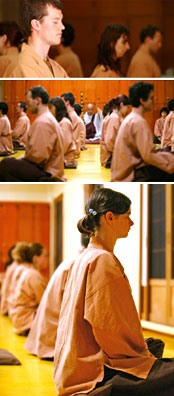
Seon is a form of meditation similar to Zen that allows a person to reflect on oneself. Korea is renowned for retaining this outstanding meditation tradition that continues to flourish today. Korean Buddhism proudly continues the meditation tradition with two 3-month intensive retreats, one in the summer and one in the winter.
All Buddhist traditions include some form of meditation, and Seon is way to practice meditation in Mahayana Buddhism. This meditation brings an end to the 'monkey mind' that we all experience so that our minds become clear and we can return to our original self. There are many other terms for this return to the original self, including enlightenment, awakening, and realizing one's Buddha nature.
Balwoo-gongyang (Communal Buddhist Meal Service)
Even taking a meal is part of a monk's religious practice. Before eating, a monk thinks in gratitude of the countless number of people who were involved, directly or indirectly, in the production, processing and preparation of the meal. He also thinks of the endless number of beings suffering from hunger and starvation. And he thinks of the equality and harmony of the community of monks he is sharing the meal with. The true Korean Buddhist meal offering (Balwoo-gongyang, literally "Bowl Offering") is one in which the participant strives to keep in mind the law of interdependence of everything and, consequently, great compassion for all sentient beings.
The meal offering is conducted in the half-lotus position and in total silence, without even the wooden spoons and chopsticks making a sound, and not a single grain of rice is wasted. There is no talking, with the monks chanting being the only words uttered in this stirring ritual.
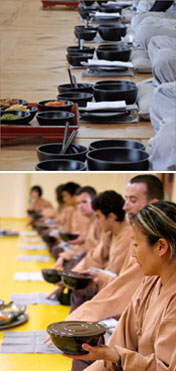
Dado (Tea Ceremony)
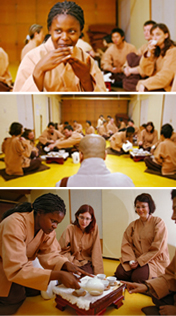
Making and enjoying good tea is one of the practices of the Buddhist religion. Koreans say that there are several ways to enjoy good tea. One should start off by enjoying the sounds of water boiling, and then relaxing with the soothing aroma of tea and seeing its soft and subtle colors. Lastly, one can feel the warmth of the tea radiating through the cup as they slowly savor the taste.
The Korean tradition of drinking tea features neither the formality of Japan nor the popular daily routines of China and the West. It is somewhere in between, with the freedom of being neither totally monastic nor totally secular.
For centuries, Seon meditators have enjoyed tea drinking as a means of reflecting upon themselves, nature, and the principles of the universe. Predecessors have said that tea drinking affords the opportunity to quietly appreciate the tea fragrance, color and beauty; and by striving for truth in this, tea drinking can lead one to the world of enlightenment, thereby making the concentration in tea drinking a form of Seon in itself. This gave rise to the saying, "Seon and tea are the same flavor."
Ulyeok (Community Work)
Ulyeok means residents in the temple all work together. Ulyeok represents Korean Seon tradition well. One rule of Seon is a day without work is a day without food. All Korean temples keep this rule, and it is not merely an admonishment, but in the self-sufficient life in a remote Buddhist temple it is an axiom of practicality.
Normally Ulyeok starts after breakfast, and may include farming, cleaning the living quarters or sweeping the courtyard. This is not just physical work, but should be seen as another way of practicing and developing patience and discipline. While not as intensive as Seon meditation, the rhythmic routine of basic work affords a strong foundation for the monks' daily practice.
Also, after meditating, reading sutras, and worship, monks find Ulyeok relaxing. Sweeping autumn leaves from the courtyard or snow from the pathways provides an opportunity to relate quietly with nature and with each other in the community of work. Taking part in Ulyeok is a way for visitors to express gratitude to the hosts, and to join in an important daily ritual.
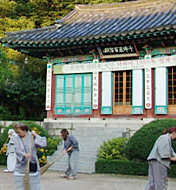
Temple Tour
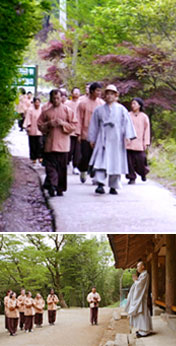
A large number of Korea's cultural assets are Buddhist in nature - more than 65% in fact. Buddhist temples are among the most impressive and comprehensive of these assets, preserving a variety of national cultural assets such as architecture, sculpture, crafts and paintings. These represent religious and artistic creations spanning from the 7th century in the Three Kingdoms Period through the Joseon Dynasty, which ended in 1910.
Temples utilize and display traditional architecture, and house and utilize other historical assets like paintings, Dancheong (Buddhist ways of coloring), Seungmu (Buddhist dancing), and Bumpae (Buddhist music). Korean traditions are maintained by temples as living arts.
Most Korean temples are located deep in the mountains. This is a unique aspect of Korean Buddhist culture. Temples blend harmoniously with their natural environment, enhancing the landscape and embodying serenity. One can feel at peace in such a place, and also experience traditional Korean culture at these sites.
Schedule
First Day
Second Day
*This is a typical schedule. It may vary slightly, depending on the temple. Temple stay for intensive meditation or for rest is available at some temples. Temple stay duration can be extended.
Inquire/bookList of Temples available for Temple Stay
Copyright © 2004-2024 Antique Alive. All Rights Reserved.






